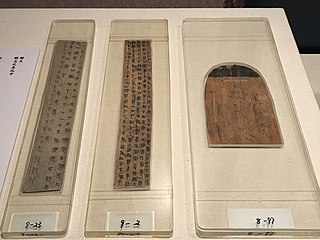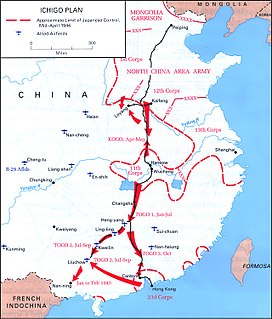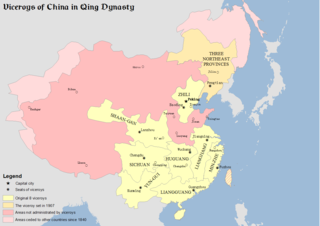 W
WThe 2017 China floods began in early June 2017. More than 14.9017 million people in 10 provinces and municipalities and regions were affected, especially the southern and central provinces and regions of Guangxi, Guangdong, Hunan, Hubei, Jiangxi, Jiangsu, Anhui, Zhejiang, Shandong, Shaanxi, Yunnan, Sichuan, Gansu and Henan. Hunan was the hardest hit. A total of 18,100 houses were destroyed, and more than 9,821-square-metre (105,710 sq ft) of crops were inundated.
 W
WThe Autumn Harvest Uprising was an insurrection that took place in Hunan and Jiangxi provinces, China, on September 7, 1927, led by Mao Zedong, who established a short-lived Hunan Soviet.
 W
WThe Battle of Changde was a major engagement in the Second Sino-Japanese War in and around the Chinese city of Changde (Changteh) in the province of Hunan. During the battle, the Imperial Japanese Army extensively used chemical weapons.
 W
WThe Changsha Kingdom was a kingdom within the Han Empire of China, located in present-day Hunan and some surrounding areas. The kingdom was founded when Emperor Gaozu granted the territory to his follower Wu Rui in 203 or 202 BC, around the same time as the establishment of the Han dynasty. Wu Rui and his descendants held the kingdom for five generations until Wu Zhu died without an heir in 157 BC. In 155 BC, the kingdom was reestablished for a member of the imperial family. However, the creation of this second kingdom coincided with the Rebellion of the Seven States and the subsequent reforms under Emperor Jing, and Changsha under the imperial family saw its autonomy greatly diminished. The kingdom was dissolved during Wang Mang's usurpation, briefly restored after the founding of the Eastern Han, and finally abolished in AD 33 and converted to a commandery under the imperial government.
 W
WThe encirclement campaign against the Hunan-Hubei-Jiangxi Soviet was a military campaign launched by the Kuomintang Nationalist Government against the communist Soviet force in the Hunan-Hubei-Jiangxi. It was responded to with the Communists' Counter-encirclement campaign at the Hunan-Hubei-Jiangxi Soviet, also called their Counter-encirclement campaign at the Hunan-Hubei-Jiangxi Revolutionary Base. The local red army successfully defended this soviet republic against the government attacks from December 1930 through to May 1931.
 W
WHuguang was a province of China during the Yuan and Ming dynasties. It was founded by the Yuan dynasty in 1274. During the Yuan dynasty it included the areas of modern Hubei south of the Yangtze river, Hunan, Guizhou, and Guangxi. During the Ming dynasty it came to include just the modern provinces of Hubei and Hunan, in the process adding areas north of the Yangtze. It was partitioned in 1644 by the newly established Qing dynasty, becoming the provinces of Hubei and Hunan, which were administered by the viceroy of Lianghu.
 W
WThe Liye Qin Slips is a large collection of bamboo slips which were unearthed from Liye Ancient City in Longshan County, Hunan, China in 2002. It is one of China's most important archaeological discoveries of the 21st century. Archaeologists found more than 37,000 pieces of bamboo slips, on which more than 200,000 Chinese characters record government and legal documents of the Qin dynasty. It is considered the most important archaeological discovery of the Qin dynasty after the Terracotta Army unearthed in 1973 in Xi'an.
 W
WThe Miao Rebellion of 1795–1806 was an anti-Qing uprising in Hunan and Guizhou provinces, during the reign of the Jiaqing Emperor. It was catalyzed by tensions between local populations and Han Chinese immigrants. Bloodily suppressed, it served as the antecedent to the much larger uprising of Miao Rebellion (1854–73).
 W
WOn 12 September 2018, a man deliberately drove his SUV into crowds on a square in Mishui near Hengyang in Hunan Province, China. The attack resulted in the deaths of 15 people and injuries to 43 others. The attacker, Yang Zanyun, was sentenced to death and executed.
 W
WOperation Ichi-Go was a campaign of a series of major battles between the Imperial Japanese Army forces and the National Revolutionary Army of the Republic of China, fought from April to December 1944. It consisted of three separate battles in the Chinese provinces of Henan, Hunan and Guangxi.
 W
WThe Pengtoushan culture was a Neolithic culture located around the central Yangtze River region in northwestern Hunan province, China. It dates to around 7500–6100 BC, and was roughly contemporaneous with the Peiligang culture to the north. It is named after the type site at Pengtoushan.
 W
WThe Shaoyang County Massacre, also known as the "Black Killing Wind" Incident, was a massacre in Shaoyang County of Hunan Province during the Chinese Cultural Revolution. According to the official statistics in 1974, from July to September of 1968, a total of 11,177 people were arrested with 7,781 imprisoned and 113 permanently disabled, while the death toll of the massacre was 991, including 699 who were forced to commit suicide. However, some researchers argue that thousands of people died in the massacre.
 W
WThe Shijiahe culture was a late Neolithic culture centered on the middle Yangtze River region in Shijiahe Town, Tianmen, Hubei Province, China. It succeeded the Qujialing culture in the same region and inherited its unique artefact of painted spindle whorls. Pottery figurines and distinct jade worked with advanced techniques were also common to the culture.
 W
WThe Viceroy of Huguang, fully referred to in Chinese as the Governor-General of Hubei and Hunan Provinces and the Surrounding Areas; Overseeing Military Affairs, Food Production; Director of Civil Affairs, was one of eight regional Viceroys in China proper during the Qing dynasty. The Viceroy of Huguang had jurisdiction over Hubei and Hunan provinces, which were previously a single province called "Huguang Province" in the Ming dynasty, hence the name "Huguang".
 W
WThe Xiang Army or Hunan Army was a standing army organized by Zeng Guofan from existing regional and village militia forces called tuanlian to contain the Taiping Rebellion in Qing China. The name is taken from the Hunan region where the Army was raised. The Army was financed through local nobles and gentry, as opposed to through the centralized Manchu-led Qing dynasty. The army was mostly disbanded by Zeng after the re-capture of the Taiping capital at Nanking.